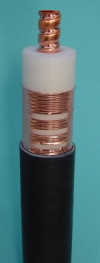RAY114-50JFNA
1-1/4" RADIAFLEX® RAY Cable, A-series
Rev : P2 | Rev date : 19 Sep 2024
- RADIAFLEX® functions as a distributed antenna to provide communications in tunnels, mines and large building complexes and is the solution for any application in confined areas.
- Slots in the copper outer conductor allow a controlled portion of the internal RF energy to be radiated into the surrounding environment. Conversely, a signal transmitted near the cable will couple into the slots and be carried along the cable length.
- RADIAFLEX® is used for both one-way and two-way communication systems and because of its broadband capability, a single radiating cable can handle multiple communication systems simultaneously.
- This RADIAFLEX® radiating cable utilize a low-loss cellular polyethylene foam dielectric and a smooth copper outer conductor which offers a superior electrical performance together with good bending properties.
FEATURES / BENEFITS
- Broadband from 30 MHz to 1000 MHz
- Optimized for high frequencies and digital transmission
- Low coupling loss variation
- For tunnel applicationsV

picture shows generic slot pattern
General Specifications |
|---|
| Size | | 1-1/4 |
|
Electrical Specifications |
|---|
| Max. Operating Frequency | MHz | 1000 | | Cable Type | | RAY | | Impedance | Ohm | 50 +/- 2 | | Velocity, percent | % | 89 | | Capacitance | pF/m (pF/ft) | 75 (22.9) | | Inductance, uH/m (uH/ft) | µH/m (µH/ft) | 0.188 (0.057) | | DC-resistance inner conductor, ohm/km (ohm/1000ft) | Ω/km (Ω/1000ft) | 0.84 (0.26) | | DC-resistance outer conductor, ohm/km (ohm/1000ft) | Ω/km (Ω/1000ft) | 1.85 (0.56) | | Stop bands | MHz | 240-300, 500-590, 750-860 | | Frequency Selection | MHz | 600, 900 |
|
Mechanical Specifications |
|---|
| Jacket | | JFN, EN50575:2017 classified cable | | Jacket Description | | Halogen free, non corrosive, flame and fire retardant, low smoke, polyolefin | | Slot Design | | Groups of slope slots at short intervals | | Inner Conductor Material | | Corrugated Copper Tube | | Outer Conductor Material | | Overlapping Copper Strip | | Diameter Inner Conductor | mm (in) | 13.9 (0.55) | | Diameter Outer Conductor | mm (in) | 34 (1.34) | | Diameter over Jacket Nominal | mm (in) | 38.1 (1.5) | | Minimum Bending Radius, Single Bend | mm (in) | 500 (20) | | Cable Weight | kg/m (lb/ft) | 0.87 (0.58) | | Tensile Force | N (lb) | 2000 (440) | | Indication of Slot Alignment | | Guides opposite to slots | | Recommended / Maximum Clamp Spacing | m (ft) | 1.3 (4.25) | | Minimum Distance to Wall | mm (in) | 80 (3.15) |
|
Testing and Environmental |
|---|
| Jacket Testing Methods | | Test methods for fire behaviour of cable :
IEC 60754-1/-2 smoke emission: halogen free, non corrosive
IEC 61034 low smoke
IEC 60332-1 flame retardant
IEC 60332-3-24 fire retardant
UL1666, ASTM E 662, NES711 and NES713
EN50575:2017 class Dca s1 d2 a1 |
|
Temperature Specifications |
|---|
| Storage Temperature | °C(°F) | -70 to 85 (-94 to 185 ) | | Installation Temperature | °C(°F) | -25 to 60 (-13 to 140 ) | | Operation Temperature | °C(°F) | -40 to 85 (-40 to 185 ) |
|
Attenuation and Power Rating |
|---|
| Frequency, MHz | Longitudinal Loss, dB/100 m (dB/100 ft) | Coupling Loss 50%, dB | Coupling Loss 95%, dB |
| 75 |
0,68 (0,21) |
58 (62) |
68 (72) |
| 150 |
0,97 (0,30) |
66 (70) |
76 (80) |
| 450 |
1,84 (0,56) |
64 (66) |
68 (70) |
| 870 |
3,62 (1,10) |
56 (58) |
65 (67) |
| 900 |
3,74 (1,14) |
56 (58) |
65 (67) |
| 960 |
4,27 (1,30) |
56 (58) |
63 (65) |
|
Notes
- Coupling loss as well as longitudinal attenuation of RADIAFLEX® cables are measured by the free space method according to IEC 61196-4.
- Coupling loss values are measured with a radial (below 300 MHz) or orthogonal (above 300 MHz) orientated dipole antenna.
- The coupling loss values given in brackets are average values of all three spatial orientations (radial, parallel and orthogonal) of dipole antenna.
- Coupling loss values are given with a tolerance of +5 dB and longitudinal loss values with a tolerance of +5%. Note: Measured values below nominal are better. They are not limited by any tolerance-range.
- In case of a conflict of operational and stop band, please contact RFS Technologies for further assistance.
- As with any radiating cable, the performance in building or tunnel environments may deviate from figures based on free space method.
;

